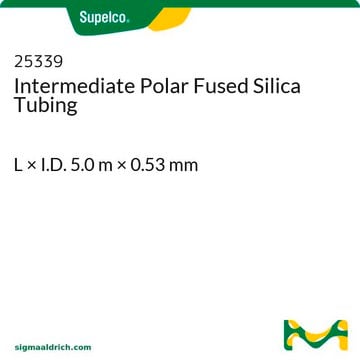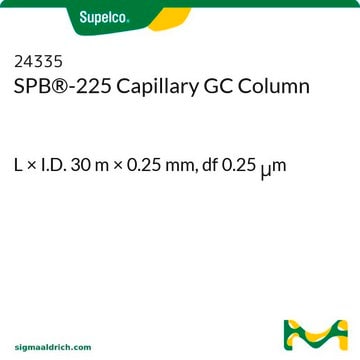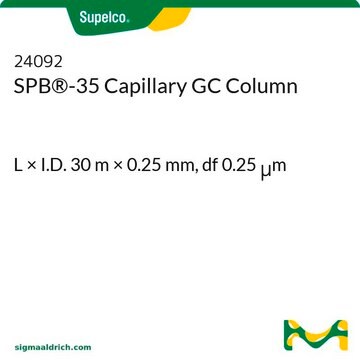If this product has an expiration or retest date, it will be shown on the Certificate of Analysis (COA, CofA). If there is no retest or expiration date listed on the product's COA, we do not have suitable stability data to determine a shelf life. For these products, the only date on the COA will be the release date; a retest, expiration, or use-by-date will not be displayed.
For all products, we recommend handling per defined conditions as printed in our product literature and website product descriptions. We recommend that products should be routinely inspected by customers to ensure they perform as expected.
For products without retest or expiration dates, our standard warranty of 1 year from the date of shipment is applicable.
For more information, please refer to the Product Dating Information document: https://www.sigmaaldrich.com/deepweb/assets/sigmaaldrich/marketing/global/documents/449/386/product-dating-information-mk.pdf
25396
OVI-G43 Capillary GC Column
L × I.D. 30 m × 0.53 mm, df 3.00 μm
About This Item
Recommended Products
material
fused silica
Agency
meets requirements for USP G43
parameter
-20-260 °C temperature (isothermal or programmed)
Beta value
44
df
3.00 μm
technique(s)
gas chromatography (GC): suitable
L × I.D.
30 m × 0.53 mm
matrix active group
Bonded; poly(6% cyanopropylphenyl/94% dimethyl siloxane) phase
application(s)
pharmaceutical (small molecule)
column type
capillary intermediate polar
Related Categories
General description
USP Code: This column meets USP G43 requirements.
Phase:
- Bonded
- Poly(6% cyanopropylphenyl/94% dimethyl siloxane)
- -20 °C to 260 °C (isothermal or programmed)
Other Notes
Storage Class Code
11 - Combustible Solids
WGK
WGK 3
Flash Point(F)
Not applicable
Flash Point(C)
Not applicable
Choose from one of the most recent versions:
Already Own This Product?
Find documentation for the products that you have recently purchased in the Document Library.
Customers Also Viewed
Articles
Analysis of carbonate solvents in lithium-ion batteries like ethylene carbonate, dimethyl carbonate, diethyl carbonate, and more using SPB®-624 column.
Analysis of carbonate solvents in lithium-ion batteries like ethylene carbonate, dimethyl carbonate, diethyl carbonate, and more using SPB®-624 column.
Analysis of carbonate solvents in lithium-ion batteries like ethylene carbonate, dimethyl carbonate, diethyl carbonate, and more using SPB®-624 column.
Analysis of carbonate solvents in lithium-ion batteries like ethylene carbonate, dimethyl carbonate, diethyl carbonate, and more using SPB®-624 column.
Protocols
Static headspace GC (GC-SH) concentrates volatile analytes for improved detection and minimizes matrix interference.
Static headspace GC (GC-SH) concentrates volatile analytes for improved detection and minimizes matrix interference.
Static headspace GC (GC-SH) concentrates volatile analytes for improved detection and minimizes matrix interference.
Static headspace GC (GC-SH) concentrates volatile analytes for improved detection and minimizes matrix interference.
-
How can I determine the shelf life / expiration / retest date of this product?
1 answer-
Helpful?
-
-
How is shipping temperature determined? And how is it related to the product storage temperature?
1 answer-
Products may be shipped at a different temperature than the recommended long-term storage temperature. If the product quality is sensitive to short-term exposure to conditions other than the recommended long-term storage, it will be shipped on wet or dry-ice. If the product quality is NOT affected by short-term exposure to conditions other than the recommended long-term storage, it will be shipped at ambient temperature. As shipping routes are configured for minimum transit times, shipping at ambient temperature helps control shipping costs for our customers. For more information, please refer to the Storage and Transport Conditions document: https://www.sigmaaldrich.com/deepweb/assets/sigmaaldrich/marketing/global/documents/316/622/storage-transport-conditions-mk.pdf
Helpful?
-
Active Filters
Our team of scientists has experience in all areas of research including Life Science, Material Science, Chemical Synthesis, Chromatography, Analytical and many others.
Contact Technical Service







